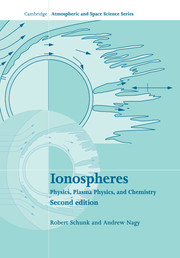Book contents
- Frontmatter
- Contents
- Chapter 1 Introduction
- Chapter 2 Space environment
- Chapter 3 Transport equations
- Chapter 4 Collisions
- Chapter 5 Simplified transport equations
- Chapter 6 Wave phenomena
- Chapter 7 Magnetohydrodynamic formulation
- Chapter 8 Chemical processes
- Chapter 9 Ionization and energy exchange processes
- Chapter 10 Neutral atmospheres
- Chapter 11 The terrestrial ionosphere at middle and low latitudes
- Chapter 12 The terrestrial ionosphere at high latitudes
- Chapter 13 Planetary ionospheres
- Chapter 14 Ionospheric measurement techniques
- Appendix A Physical constants and conversions
- Appendix B Vector relations and operators
- Appendix C Integrals and transformations
- Appendix D Functions and series expansions
- Appendix E Systems of units
- Appendix F Maxwell transfer equations
- Appendix G Collision models
- Appendix H Maxwell velocity distribution
- Appendix I Semilinear expressions for transport coefficients
- Appendix J Solar fluxes and relevant cross sections
- Appendix K Atmospheric models
- Appendix L Scalars, vectors, dyadics, and tensors
- Appendix M Radio wave spectrum
- Appendix N Simple derivation of continuity equation
- Appendix O Numerical solution for F region ionization
- Appendix P Monte Carlo methods
- Index
Chapter 12 - The terrestrial ionosphere at high latitudes
Published online by Cambridge University Press: 22 January 2010
- Frontmatter
- Contents
- Chapter 1 Introduction
- Chapter 2 Space environment
- Chapter 3 Transport equations
- Chapter 4 Collisions
- Chapter 5 Simplified transport equations
- Chapter 6 Wave phenomena
- Chapter 7 Magnetohydrodynamic formulation
- Chapter 8 Chemical processes
- Chapter 9 Ionization and energy exchange processes
- Chapter 10 Neutral atmospheres
- Chapter 11 The terrestrial ionosphere at middle and low latitudes
- Chapter 12 The terrestrial ionosphere at high latitudes
- Chapter 13 Planetary ionospheres
- Chapter 14 Ionospheric measurement techniques
- Appendix A Physical constants and conversions
- Appendix B Vector relations and operators
- Appendix C Integrals and transformations
- Appendix D Functions and series expansions
- Appendix E Systems of units
- Appendix F Maxwell transfer equations
- Appendix G Collision models
- Appendix H Maxwell velocity distribution
- Appendix I Semilinear expressions for transport coefficients
- Appendix J Solar fluxes and relevant cross sections
- Appendix K Atmospheric models
- Appendix L Scalars, vectors, dyadics, and tensors
- Appendix M Radio wave spectrum
- Appendix N Simple derivation of continuity equation
- Appendix O Numerical solution for F region ionization
- Appendix P Monte Carlo methods
- Index
Summary
The magnetosphere–ionosphere–atmosphere system at high latitudes is strongly coupled via electric fields, particle precipitation, field-aligned currents, heat flows, and frictional interactions, as shown schematically in Figure 12.1. Electric fields of magnetospheric origin induce a large-scale motion of the high-latitude ionosphere, which affects the electron density morphology. As the plasma drifts through the neutrals, the ion temperature is raised owing to ion–neutral frictional heating. The elevated ion temperature then alters the ion chemical reaction rates, topside plasma scale heights, and ion composition. Also, particle precipitation in the auroral oval acts to produce enhanced ionization rates and elevated electron temperatures, which affect the ion and electron densities and temperatures. These ionospheric changes, in turn, have a significant effect on the thermospheric structure, circulation, and composition. At F region altitudes, the neutral atmosphere tends to follow, but lags behind, the convecting ionospheric plasma. The resulting ion–neutral frictional heating induces vertical winds and O/N2 composition changes. These atmospheric changes then affect the ionospheric densities and temperatures.
The ionosphere–thermosphere system also has a significant effect on the magnetosphere. Precipitating auroral electrons produce conductivity enhancements, which can modify the convection electric field, large-scale current systems, and the electrodynamics of the magnetosphere–ionosphere system as a whole. Also, once the thermosphere is set into motion by convection electric fields, the large inertia of the neutral atmosphere will act to produce dynamo electric fields whenever the magnetosphere tries to change its electrodynamic state. Additional feedback mechanisms exist on polar cap and auroral field lines via a direct flow of plasma from the ionosphere to the magnetosphere.
- Type
- Chapter
- Information
- IonospheresPhysics, Plasma Physics, and Chemistry, pp. 398 - 481Publisher: Cambridge University PressPrint publication year: 2009



